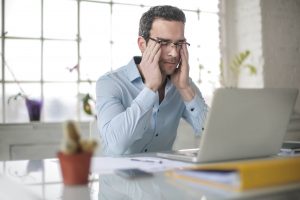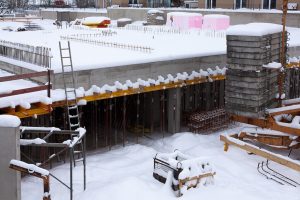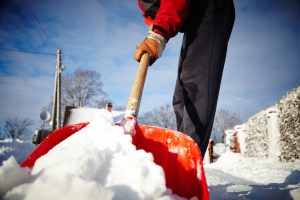
Beating the winter blues – When workers are SAD
As staff enter the latest COVID-19 lockdown and this coincides with shorter, darker days, managers may find it useful to share information on how best to beat symptoms of the winter blues — or seasonal affective disorder (SAD) — wherever employees are working.
According to the NHS, symptoms of SAD can include:
•a persistent low mood
•a loss of pleasure or interest in normal everyday activities
•irritability
•feelings of despair, guilt and worthlessness
•feeling lethargic (lacking in energy) and sleepy during the day
•sleeping for longer than normal and finding it hard to get up in the morning
•craving carbohydrates and gaining weight.
For some people, these symptoms can be severe and have a significant impact on their day-to-day activities. Workers should consider seeing their GP if they are struggling to cope and the doctor will most likely assess their mental health, asking questions about their mood, lifestyle, eating habits and sleeping patterns, plus any seasonal changes in their thoughts and behaviour.
It is thought that lack of sunlight might stop a part of the brain called the hypothalamus working properly, which may affect the production of melatonin and serotonin (the neurotransmitters responsible for sleep and mood) as well as the body’s internal body clock.
A range of treatments are available for SAD but the most common treatments include:
•lifestyle measures ― getting as much natural sunlight as possible, exercising regularly and managing stress levels
•light therapy, where a special lamp called a light box is used to simulate exposure to sunlight
•talking therapies such as cognitive behavioural therapy (CBT) or counselling
•antidepressant medication such as selective serotonin reuptake inhibitors (SSRIs).
Eating well can help too: people should drink lots of water and eat foods containing omega-3 fatty acids (such as salmon and mackerel) and amino acids (such as eggs, nuts, fish, whole grains and spinach). These foods are readily converted into serotonin, which may help to boost mood.
Search out previous blogs for advice. How to help someone with SAD.
Contact us for further information.

Ways to improve your forklift truck safety this winter
Forklifts come with risks no matter what the time of the year. However, when the winter brings cold, wet and icy weather, the risks can significantly increase. Kelly Friel is the Digital Product Manager from PPE and tool retailer, Zoro. Here, she explains how you can improve your forklift truck safety during the colder months.
If you work in construction or warehousing, forklifts can be a lifeline to your daily duties. But, while they can be incredibly useful in shaving down labour time and removing the need for workers to move heavy materials, they can pose a lot of health and safety issues. According to latest statistics reported to the HSE, some of the main causes of worker fatality include being struck by a moving vehicle (20%), trapped by something collapsing or overturning (15%), and contact with moving machinery (11%) — all of which are possibilities when working with, or around, powerful machinery like forklifts (Workplace Fatal Injuries in Great Britain, 2020).
And, with winter on the horizon, the conditions on your construction site or yard could soon become treacherous. Not only does this directly affect forklift truck drivers, but also the workers around them. Here, I’ll be sharing my top tips for improving your site’s forklift truck safety during the colder months.
Knowing how to properly operate a forklift, and how to deal with any problems that arise, will be key to safety on the site for everybody. With slippery surfaces, reduced lighting and strong winds to contend with during winter, your forklift truck drivers may need some additional training, particularly if you’re planning to add extra safety measures around the site, such as a new route for machinery. Similarly, ensuring they know exactly what checks to carry out at the beginning of each shift, and are aware that they’ll need to give the forklift some time to warm up before operation, will be imperative to safe and optimum usage.
As well as this, you also might want to impose some restrictions on forklift usage. For example, while it might not be productive to limit the hours the forklift can be used, limiting the speed at which it can travel after a certain time and in particular conditions can improve the safety on site for everyone. You could even implement some speedbumps to ensure drivers stick to these limits and are warned for when coming up to particularly dangerous zones.
If you’re unsure on the additional training you’ll need to give, finding a consultancy that offers guidance and health and safety training, like Walker Health and Safety Services, will ensure you’re identifying and managing all potential risks for your workers and site visitors.
Before you let your workers carry on their duties, it’s imperative that you have done the necessary checks and changes to your forklift to ensure it’s fit for purpose during the winter. This could include investing in some durable forklift covers that will shield it from wind, rain, ice and other elements, which could impact its usual functioning. These covers can vary from metal cabs to plastic canopies, and the type you choose will depend on where your forklift is stored and, consequentially, how much extra protection and shelter it’ll need.
For construction sites, you’ll want to consider changing the tyres to ones that are suitable for challenging weather conditions. These tyres have greater traction, so won’t be as phased by wet and icy flooring around your site, reducing the chances of your forklifts skidding and causing damage or injury. For machinery that regularly goes between indoor and outdoors, you might even want to consider buying some pneumatic tyres that handle slippery floors better. These are typically best for forklifts that are lifting heavyweight materials, such as bricks, so you may need to add some tyre chains and studs to offer extra traction.
It’s important to remind workers that during these wetter months, it’s key for them to clean the forklift down after every shift. This will help to remove any build ups of dirt and debris. And, by drying the forklift’s body before storing it, they’ll also be able to spot and get rid of any rust. Each forklift will have specific care guidelines, so make sure your workers are following the daily and weekly checks outlined in the operator’s manual to keep your forklifts in great condition.
As an employer, it’s a legal requirement for you to adhere to the advice given in the Personal Protective Equipment at Work Regulations (1992). So, you no doubt already supply your workers with a sufficient amount of protective clothing when they’re on site. However, with new health and safety risks arising in the colder months, it may be necessary to take a look at what PPE is missing to protect your staff from these problems, including cold stress.
For example, it is not uncommon for cold weather to wreak havoc on your workers’ body temperatures, meaning they can have trouble regulating it when spending time outside. For this reason, it’ll be important to ensure your workers are wearing lots of thin layers rather than thicker ones, so they can choose when to take off or add layers, and can do so comfortably. The clothes your workers wear will need to stand up to the elements, so investing in some weather- and windproof materials, such as Gortex and nylon, will help them to keep warm when out on the job. Similarly, providing thick, insulated gloves and leg warmers will be key.
As the evenings draw in earlier, and we have reduced hours of daylight, it’ll be incredibly important to ensure the high-visibility PPE you offer are more than sufficient. High visibility clothing is split into three categories, with class 1 offering the most basic level of protection and class 3 offering the most. For your construction site in winter, you’ll want to invest in class 3 for everybody, even if you’ve increased extra lighting around the site. This is so forklift truck drivers can be seen and so can other workers around the site, to reduce chances of injury or fatality.
You’ll need to look beyond the safety of your forklift and ensure that your site is also safe. For example, you may need to invest in some extra lighting for the darker hours your workers will be working in. These could be floodlights or tower lights depending on the size of your site and how much additional lighting you’ll need.
If you’ve set up separate routes for pedestrians and your forklifts to travel around, you’ll need to sufficiently highlight which path is for who. So, additional signage will be key.
When the floor is particularly wet and slippery, remembering to grit it regularly, including at the beginning of each working day and a few times during the day, to reduce the amount of accidents for workers and forklift operators.
Protect your forklift operators and the rest of your workers from injuries and fatalities by taking the time to think about the risks associated with cold weather and how to tackle these.
Contact Walker Health and Safety Services if you require further information.
Guest Blogger – Kelly Friel from Zoro.
 To prepare for inclement weather, a winter plan should be put together with an associated risk assessment. This should be carried out well in advance, and revisited and revised throughout the cold period.
To prepare for inclement weather, a winter plan should be put together with an associated risk assessment. This should be carried out well in advance, and revisited and revised throughout the cold period.
To make sure everyone understands what is expected of them, and to ensure the plan is as streamlined as possible, it should be completed alongside other areas of the business — for example HR, IT and the communications team. As part of any planning process, include a review of what happened last year so that new approaches can be adopted where processes were less than ideal.
Some areas that could be addressed as part of winter planning are outlined below.
Communication with employees
Staff need to know what is expected of them when bad weather strikes, as well as what they can expect from the organisation. From an HR point of view, it is important for staff to clearly understand what the consequences are of not being able to attend work, for example due to transport disruption or emergency childcare requirements. On the other side of the coin, facilities managers also need to plan for what happens if, for any reason, staff should not come into work, for example if a building loses power or if the heating system goes down.
Communicating with staff is key in these instances, so make sure that the communication plan is clear, approved, and aligned with communication from other departments. Also ensure that managers are on board and understand what is required.
Preventive maintenance
Bad weather and high winds can expose any building flaws, especially in areas such as roofs or windows. Before winter comes, carry out a condition survey to identify any potential problems, and prioritise them for repair.
Similarly, regularly inspect heating systems and any other plant required for emergencies, such as back-up generators. Proactive maintenance and regular inspections will help reduce the chance of failure when these bits of kit are most needed.
Slips and trips
Snow and ice are two obvious winter problems that can be a hindrance to any business. Make sure that supplies of grit are fully stocked, and that weather warnings are regularly checked so that the grit is used when needed. Staff employed to spread grit need proper personal protective equipment (PPE).
Do not forget inside the building too — staff bringing snow and ice in on their shoes can create slippery surfaces, so consider adding extra mats at the front doors to help keep the building clean and to absorb any extra wetness.
Also remember that slips and trips are not just isolated to times when snow falls. Darker mornings and evenings can cause more accidents, as can autumnal leaf fall. As part of maintenance checks, ensure external lighting is adequate and that entrances and pathways are kept clear of leaf litter and debris.
Staff working outdoors
As part of the maintenance team there might be people who are regularly working outdoors. Although minimum working temperatures do not apply for these workers, there is, however, still a duty of care to ensure that people are not working in unsafe conditions. This could mean that managers need to look at rotas to avoid staff working outside in the cold for long periods of time, as well as making sure there are adequate facilities for people to warm up and take a break. Additional PPE to account for the weather can also be appropriate — for example, having extra dry items of clothing and good waterproofs to help people stay warm.
Remote working
Part of the winter preparation might include making sure that people are able to work effectively from home. This might include checking that all staff have the relevant logins and permissions to access work servers remotely. As some staff might not regularly use these systems, ask everyone to check that they can work remotely ahead of time.
Equip fleet vehicles
Make sure fleet vehicles (including grey fleet vehicles) are prepared for winter conditions. This means making a considered decision as to whether winter tyres are necessary, as well as asking staff to undertake some basic checks on weather and road conditions before deciding to drive. It is also a good idea to put together a car “winter pack”, including a blanket, in-car phone charger and snow shovel. Staff can supplement this with personal items that could include warm clothing and food in case they do break down or are stuck on a motorway.
Managing sickness
Along with bad weather comes the dreaded winter flu. Facilities managers can play an important, if not visible, role in reducing the impact of staff illness spreading, for example by stocking up on soap and alcohol gels. It is also a good time to run a check on cleaning schedules to make sure that common areas are being properly, and thoroughly, cleaned to help reduce the spread of germs.
Furthermore, don’t forget that winter doesn’t always mean catching a cold. For some, it can also bring about the onset of Seasonal Affective Disorder (SAD) as well as a propensity for less exercise and a change in diet. Keep this in mind — perhaps renew or re-launch any wellness campaigns, or work with caterers to develop hearty, but healthy, meals for the winter menu.
Contact us if you require further information.
December blends festive celebrations with winter extremes, making it one of the most complex months for HSE management. It’s also an opportune moment for inclusion and reflection.
Key Focus Areas and Relevant UK Campaigns:
– Workload & Fatigue Prevention: Encourage balanced hours and check in with teams handling year-end responsibilities.
– Festive Celebrations: Plan social events with safety in mind—consider transport arrangements, manage alcohol responsibly, and ensure inclusivity.
– Winter Hazards: Maintain gritting, safe routes, and emergency measures for outdoor or travelling staff.
2. Inclusion & Wellbeing
– International Day of Persons with Disabilities – 3 December: This UN-led observance encourages awareness of disability issues and inclusive practices (https://awareness-days.co.uk/awareness-day/international-day-of-persons-with-disabilities/2025-12-03/). Use it as a reminder to review workplace accessibility, ensure holiday events are inclusive, and highlight support for staff who may find the festive period isolating or challenging.
3. Environmental Stewardship
– Year-End Energy Management: Promote a “switch-off” initiative for unused equipment and appliances to reduce waste and cost.
– Sustainable Festivities: Avoid single-use plastics, encourage recycling, and choose eco-friendly decor and catering options.
4. Reflection & Planning
December is also the time to review progress against HSE objectives for the year and set fresh goals for the year ahead. Celebrating achievements while identifying areas for improvement ensures momentum carries into January.
This blog positions your business as both caring and professional—balancing safety, culture, and sustainability at a critical time of year.
Contact us for you health and safety requirements.
Slips and Trips in Icy Weather: Don’t Let Winter Catch You Off Guard
As temperatures drop and pavements freeze, the risks of slips and trips rises sharply. Icy surfaces are deceptively dangerous—what looks like a harmless patch of frost could send you flying.
Slips and trips in icy weather aren’t just inconvenient—they can lead to serious injury. A few simple precautions can make all the difference.
Contact us if you require further guidance.